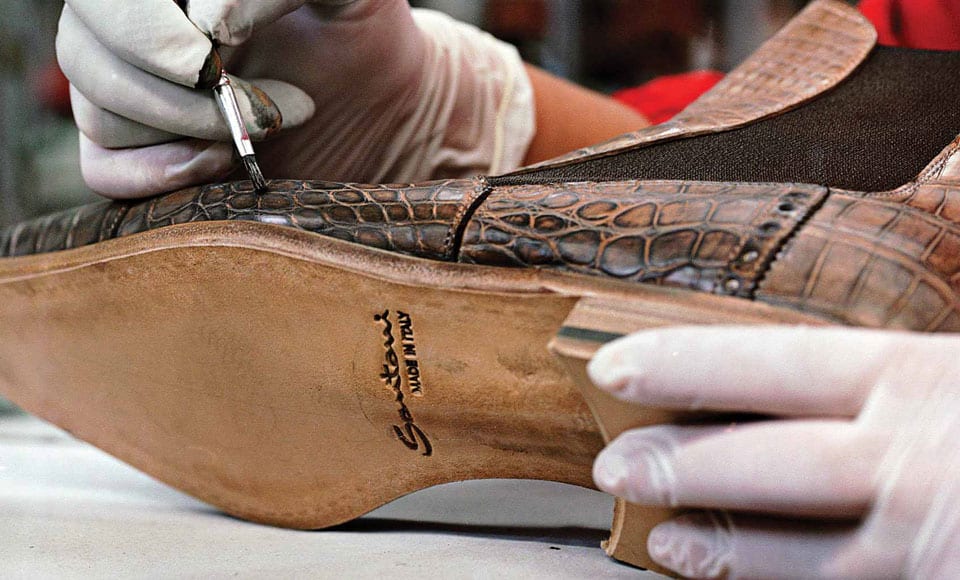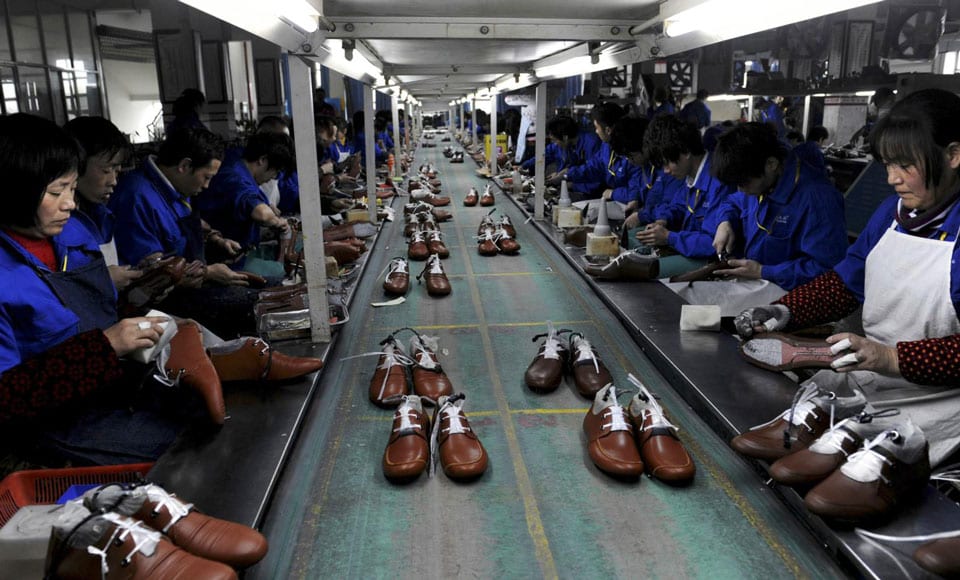Never skimp on a pair of leather shoes. It’s a saying you’ve probably heard of before but never really wondered why. Today we’re going to answer that question.
Whether it’s a classic lace-up dress shoe or a casual pair of driving shoes, there’s a craft that goes into constructing every kind of leather shoe for men. What we’re exploring here is why some can cost well in excess of $1,000 whilst others can retail for around $60.
Isn’t a leather shoe just a leather shoe? Not quite.
Helping us on this journey into understanding the leather shoe game is Gabi Levi, founder of driving shoe brand Eve & Kane and Kaz of Kazuna, the only label providing custom-made Japanese leather shoes and boots to the Australian market.
In This Story…
How To Spot A Quality Leather Shoe
Before dropping your hard earned coin on any leather made shoe, it’s important to understand the qualities that make a good one.
According to Gabi Levi and Kaz, these are the traits you should always be looking for when hunting for the perfect leather shoe.
- Leather and suede flexibility – the softer the leather, the more comfortable it is on the feet. The downside to this is that it doesn’t last as long as thicker leather constructions which can also be cheaper to use
- Smell the inside of the shoe – if it smells like glue, you know it’s been made on the cheap with glue bonding as opposed to stitching
- Smell the leather – a good quality leather shoe needs to smell like good quality leather (i.e. non-synthetic smell)
- The soles of leather shoes are vital components – Kaz explains that high-end luxury shoes often have “hidden channels” where you can’t see the stitching on the bottom of the shoe. It’s a more elegant look which can add to the final cost of the leather dress shoe (see below)

- Leather grading is important – good quality leather should last longer and hold its shape more, especially in a deconstructed shoe like loafers
- When trying on leather shoes, try to feel the firmness of the inner sole. This will determine how comfortable the shoe is and its general quality
- Expensive shoes will use a better quality sole that’s designed to last up to three times longer than the average lifespan
How To Spot A Bad Quality Leather Shoe
Levi explains that for leather driver shoes or loafers, it’s always important to check how flimsy the finished product is.
If the shoe is too soft and flexible, it’ll likely be more comfortable but it won’t last as long and it won’t keep its shape.
Visually, you can also check things like:
- Stitching tightness
- Stitching spacing consistency
- Depth of the stitch (one lower than other or loose)
Hand Stitched vs Machine Stitched
All leather shoes are handmade to an extent as there’s no machine that can do the whole process autonomously from start to finish just yet. In other words, if a leather shoe claims to be “Handmade in Italy” or any other fancy country, it’s likely more of a marketing play than a reflection of the quality.
When addressing the point of manufacturing, both Kaz and Levi agree that the comparison should always be between a hand stitched leather shoe vs. a machine stitched leather shoe.
That’s where their shared opinion stops though.
Levi of Eve & Kane says…
“There’s this perception that if it’s hand stitched it’s better quality. In my opinion, it’s not the case. I personally think machine stitched is more precise and the stitch itself is tighter. I think machine stitching can last longer too. Hand stitching can be more expensive because the shoemaker has to sit there and stitch it, but it doesn’t necessarily equate to better quality.”
“Some hand stitched shoes out of Italy and Portugal aren’t nice looking shoes because you can tell the imperfections in them. Some people like that and call it ‘character’, but I personally call it sh*t and would go with machine stitched.”
“If you’re spending $300 to $500 on an Italian ‘handmade’ shoe, you’d want it to be precise.”
Kaz of Kazuna says…
“If it’s really a hand stitched product then you can avoid the tension. That’s how it creates the softness and comfort in the leather shoe. I think it’s much better than machine sewn.”
“But the real question is the stitch quality. Is the stitch a straight line or crooked? Italians might say the imperfection is just the character. The Japanese will say we have to redo it again.”
“Just between machine sewn and hand sewn, I think hand sewn is better because of the tension control.”
Does It Matter Where It’s Made?

Ah, the million dollar question. Whilst there’s no doubt that ‘Made in Italy’ carries with it a premium connotation for leather shoes, both Kaz and Levi warn that this label alone shouldn’t be the defining factor in your purchase.
In fact, whilst the Italians have earned their reputation for high quality shoemaking, customers should be vigilante against those who are exploiting the perception of ‘Made in Italy’ these days.
What Levi says…
“Most people have a stupid perception that if it’s made in Italy, it’s great. It really comes down to the individual factory.”
“The are amazing factories in Milan and also crap ones. The same goes for Portugal and China. Wherever it is, there’s always good and bad. It comes down to the factory’s experience and I don’t think where it’s made is important anymore.”
“The shoemakers in Italy, the artisans there are very traditional. They’ve been making shoes the same way for generations. Yes, they like to stick to their ways, but the Chinese are far superior when it comes to shoe making technology. They have CAD renderings and they can laser engrave any sort of material.”
“When it comes to dress shoes, the English make a good pair as well but again, it depends on who is manufacturing the shoe. I do think some countries are superior.”
What Kaz says…
“I don’t think country of manufacture matters. This goes in anything – not just leather shoes but suits and fabrics too. I wouldn’t dislike the Chinese made quality, just because it’s getting better and better now.”
“As for made in Italy, I think it’s hyped up a little bit. People think Italian made is always good but I’ve seen terrible shoes, terrible suits and fabrics from Italy that are disappointing.”
Construction Processes That Add To Price

Made in England. Made in Italy. Made in Japan. Made in China. Whilst we’ve established that the country of manufacture doesn’t matter as much in terms of quality, there are adopted construction styles in these regions that can set leather shoes apart based on how they’re worn.
What Ross Poulakis, founder of Harrolds says…
“Like everything in fashion, investing in lasting, timeless footwear is the key. A well made pair of shoes can last a lifetime if not generations.”
“Goodyear welting, hand painting, hand stitching and premium leathers are common techniques that speak of the artisanship that goes into the construction of luxury footwear.”
What Nick Schaerf, co-founder of Double Monk says…
“High quality shoes, if well fitted, will mould to your foot over time and provide support and comfort as they wear in.”
“Full-grain leather can be conditioned and treated to remain soft and supple for decades.”
“Most high-end Italian shoes are Blake stitched, built for loafing around in piazzas rather than commuting or wearing several days a week for years on end.”
“English shoemakers can’t be beaten for sturdiness. The English bench-made shoe has its origins in military boot making, so durability has always been paramount, with refinement coming over many decades. The cornerstone component is a Goodyear welted sole.”
The Goodyear Welted Method
Kaz of Kazuna explains that the Japanese way of leather dress shoe making follows closer to the English.
“The only difference is the types of leathers, what goes inside and the quality of the cork. The method is the same.”
This method he refers to is the aforementioned Goodyear Welted method of leather shoe making. It takes more than 200 steps to complete which adds to the higher final cost, but the advantage is that the shoe is made in a way that it can be repaired and resoled countless times.
“Glued shoes are inexpensive, but you can’t repair them. And it depends on how often you’ll wear it. You’re pretty much stuck with something that you can’t wear for a very long time,” says Kaz.
“Once you like the fit of a shoe, you’ll want to keep it as long as you can and repair the sole and heel. This is the Goodyear Welt method.”
“As for Blake stitching found in expensive Italian shoes, you can repair it but maybe twice or three times at most. After that it’s unrepairable. The Goodyear Welt is a semi-lifetime method of construction.”
The reason most Italian shoemakers use Blake stitching? Lightness. The final product is lighter than the Welt produced shoe because there’s no shank and no cork – a point made by Schaerf above.
In other words, it’s more for fashion than everyday wearing.
Maintenance Matters For Cheap Or Expensive Shoes
More money equals less maintenance, right? Wrong. An expensive leather shoe isn’t easier to maintain over a cheaper one in any way. The same level of care needs to be applied to any leather shoe if you want it to last.
The price factor only plays into the option aspect once wear and tear takes its toll: Can you repair or is your only option to dump?
An expensive leather shoe will give you the option to repair at a lower cost when compared to buying a brand new shoe every time it breaks. So there’s the maths.
This is why people like Levi and Kaz have seen their ventures flourish in recent years.
Levi focuses on providing affordable luxury where his Chinese and Portuguese-made leather driving shoes and loafers target big ticket Italian names like Tod’s. He claims that his shoes are superior to the Italian made ones at less than half the price.
Kaz meanwhile focuses on bringing English quality leather shoes to his customers without the scary English price tag. He admits that $1,000 for a pair of leather shoes isn’t a viable option for the average person, and that’s the reason he’s doing what he’s doing – bringing Goodyear Welted shoes that are made in Japan at half the price of their English counterparts.
